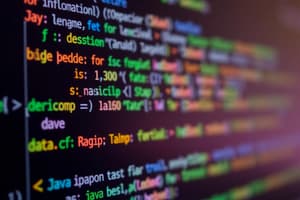Podcast
Questions and Answers
What are the primitive data types discussed in Java?
What are the primitive data types discussed in Java?
byte, short, int, long, float, double, char, Boolean
How are objects defined in Java?
How are objects defined in Java?
Using class constructs
What attributes are used to represent objects in Java?
What attributes are used to represent objects in Java?
- Primitive types
- Nested component objects
- Both a and b (correct)
- None of the above
Which types of attributes should precede the variable name when defining objects in Java?
Which types of attributes should precede the variable name when defining objects in Java?
In Java, a method definition in a class construct includes a method header and a code body.
In Java, a method definition in a class construct includes a method header and a code body.
Objects can be created using the object allocator function ___().
Objects can be created using the object allocator function ___().
Study Notes
Recap
- Objects can have diverse behavior and can be easily specified using classes
- Java provides primitive values that can be used to describe/construct bigger objects
Primitive Data Types
- Byte, short, int, and long: allow representation of discrete integer values with 8, 16, 32, and 64 bits respectively
- Float and double: allow representation of single and double precision floating points with 32 and 64 bits respectively
- Char: 16-bit characters
- Boolean: true or false values
Defining Objects
- Objects are defined using class constructs in Java
- Class constructs include:
- The keyword "class"
- Class name
- Attribute and method declarations
- Objects' attributes can be:
- Primitive types used to represent the object
- Nested component objects
- When defining objects in Java, data type precedes the variable name
- Defining data types allows:
- Anticipating values for a variable
- Setting aside storage for these values
- Knowing which operations are valid and applicable
Defining Methods
- Method definition in a class construct consists of:
- Method header
- Code body (surrounded by braces)
- A method can be invoked to correspond to a message
- The object may return a value to the sender of the message
- The type of the value being returned is the "Return Type"
- For example, if no result needs to be returned, "void" is used
Object Instantiation
- A class construct is a template for objects to be created
- No instances are created without calling the object allocator function "new()"
- For example: "new Counter()" will return a new instance of the counter class
- The new object needs to be assigned to a variable
- Multiple objects can be created using the same class template
Object Accessing & Message Passing
- Attributes and methods of an object are considered as its characteristics
- They can be accessed by the operator "."
- This operator is called the dot operator
- Objects can be initialized individually
- Total values from multiple objects can be accessed and calculated using the dot operator
Studying That Suits You
Use AI to generate personalized quizzes and flashcards to suit your learning preferences.
Related Documents
Description
This quiz covers the basics of object-oriented programming in Java, including objects, methods, and classes, as well as primitive data types.




